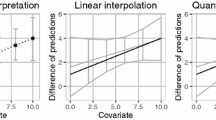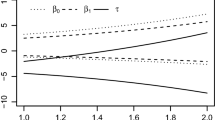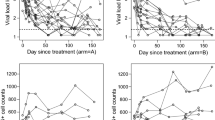Abstract
The Welch–Satterthwaite t test is one of the most prominent and often used statistical inference methods in applications. The approach is, however, not flexible with respect to adjustments for baseline values or other covariates, which may impact the response variable. Existing analysis of covariance models are typically based on the assumption of equal variances across the groups. This assumption is hard to justify in real data applications and the methods tend not to control the type-1 error rate satisfactorily under variance heteroscedasticity. In the present paper, we tackle this problem and develop unbiased variance estimators of group specific variances, and especially of the variance of the estimated adjusted treatment effect in a general analysis of covariance model. These results are used to generalize the Welch–Satterthwaite t test to covariates adjustments. Extensive simulation studies show that the method accurately controls the nominal type-1 error rate, even for very small sample sizes, moderately skewed distributions and under variance heteroscedasticity. A real data set motivates and illustrates the application of the proposed methods.






Similar content being viewed by others
References
Bell RM, McCaffrey DF (2002) Bias reduction in standard errors for linear regression with multi-stage samples. Surv Methodol 28(2):169–181
Beyersmann J, Termini SD, Pauly M (2013) Weak convergence of the wild bootstrap for the Aalen–Johansen estimator of the cumulative incidence function of a competing risk. Scand J Stat 40(3):387–402
Box GEP (1954) Some theorems on quadratic forms applied in the study of analysis of variance problems, I. effect of inequality of variance in the one-way classification. Ann Math Stat 25(2):290–302
Brunner E, Dette H, Munk A (1997) Box-type approximations in nonparametric factorial designs. J Am Stat Assoc 92(440):1494–1502
Cameron AC, Gelbach JB, Miller DL (2008) Bootstrap-based improvements for inference with clustered errors. Rev Econ Stat 90(3):414–427
Derrick B, Toher D, White P (2016) Why Welch’s test is type 1 error robust. Quant Methods Psychol 12(1):30–38
Dobriban E, Su WJ (2018) Robust inference under heteroskedasticity via the hadamard estimator. arXiv:180700347
EMA (2015) Guideline on adjustment for baseline covariates. Available from: http://www.ema.europa.eu/ema/
Flachaire E (2002) Bootstrapping heteroskedasticity consistent covariance matrix estimator. Comput Stat 17(4):501–506
Hampel FR, Ronchetti EM, Rousseeuw PJ, StahelWA (2011) Robust statistics: the approach based on influence functions, vol 196. Wiley, Hoboken
Harwell M (2003) Summarizing monte carlo results in methodological research: the single-factor, fixed-effects ancova case. J Educ Behav Stat 28(1):45–70
Hayes AF, Li C (2007) Using heteroskedasticity-consistent standard error estimators in ols regression: an introduction and software implementation. Behav Res Methods 39(4):709–722
Huber PJ (2011) Robust statistics. In: International Encyclopedia of statistical science. Springer, New York, pp 1248–1251
Imbens GW, Kolesar M (2016) Robust standard errors in small samples: some practical advice. Rev Econ Stat 98(4):701–712
Kesselman HJ, Algina J, Lix LM, Wilcox RR, Deering KN (2008) A generally robust approach for testing hypotheses and setting confidence intervals for effect sizes. Psychol Methods 13(2):110–129
Liu Y (1988) Bootstrap procedures under some non-i.i.d. models. Ann Stat 16(4):1696–1708
Long JS, Ervin LH (2000) Using heteroscedasticity consistent standard errors in the linear regression model. Am Stat 54(3):217–224
MacKinnon J, White H (1985) Some heteroskedasticity-consistent covariance matrix estimators with improved finite sample properties. J Econom 29(3):305–325
Mammen E (1993) Bootstrap and wild bootstrap for high dimensional linear models. Ann Stat 77:255–285
Patnaik PB (1949) The non-central \(\chi ^2\) and \(F\) distribution and their applications. Biometrika 36:202–232
Ruxton GD (2006) The unequal variance t-test is an underused alternative to Student’s t test and the Mann–Whitney U test. Behav Ecol 17(4):688–690
Satterthwaite FE (1946) An approximate distribution of estimates of variance components. Biom Bull 2(6):110–114
Searle SR (1987) Linear models for unbalanced data. Wiley, New York
Seber GAF, Lee AJ (1977) Linear regression analysis. Wiley, New York
Staudte RG, Sheather SJ (2011) Robust estimation and testing, vol 918. Wiley, New York
Tipton E (2015) Small sample adjustments for robust variance estimation with metaregression. Psychol Methods 20(3):375–393
Welch BL (1947) The generalization of ’student’s’ problem when several different population variances are involved. Biometrika 34(1/2):28–35
White H (1980) A heteroskedasticity-consistent covariance matrix estimator and a direct test for heteroskedasticity. Econometrica 48(4):817–838
Wilcox RR (2011) Introduction to robust estimation and hypothesis testing. Academic Press, Cambridge
Wu CFJ (1986) Jackknife, bootstrap and other resampling methods in regression analysis. Ann Stat 14:1261–1295
Young A (2016) Improved, nearly exact, statistical inference with robust and clustered covariance matrices using effective degrees of freedom corrections. Manuscript, London School of Economics
Zimmermann G, Pauly M, Bathke AC (2019) Small-sample performance and underlying assumptions of a bootstrap-based inference method for a general analysis of covariance model with possibly heteroskedastic and nonnormal errors. Stat Methods Med Res (to appear). https://doi.org/10.1177/0962280218817796
Acknowledgements
The authors are grateful to the Editor, Associate Editor and two anonymous referees for their careful reading of our manuscript and valuable suggestions, which led to a improved version of the paper. The research has been supported by the German Research Foundation (DFG KO 4680/3-2 and DFG PA 2409/3-2).
Author information
Authors and Affiliations
Corresponding author
Ethics declarations
Conflict of interest
On behalf of all authors, the corresponding author states that there is no conflict of interest.
Additional information
Publisher's Note
Springer Nature remains neutral with regard to jurisdictional claims in published maps and institutional affiliations.
Electronic supplementary material
Below is the link to the electronic supplementary material.
Appendix: Proofs
Appendix: Proofs
1.1 A.1. Proof of Theorem 1
Let \(\varvec{B}_i (\varvec{B}_i'\varvec{B}_i)^{-1} \varvec{B}_i'=\varvec{P}_{n_i}\), \(i=1, 2\) denote the projection matrix for each group in the linear model separately. Computing the expectation of the quadratic form yields
Thus, \(\widehat{\sigma }_i^2\) is an unbiased estimator of \(\sigma _i^2\), \(i=1, 2\). Next, the consistency of the variance estimators will be shown. We compute the variance of the quadratic form \(\widehat{\sigma }_i^2\) and obtain
where \(\varvec{\mu }_i=E(\varvec{Y}_i)\), \(\varvec{q}_i=diag\{\varvec{Q}_i\}\), the vector of diagonal elements of \(\varvec{Q}_i\). Here, \(\mu _3\) and \(\mu _4\) denote the skewness and kurtosis of the error distributions, respectively. Using the properties of projection matrix \(\varvec{P}_{n_i}\), we get \(0\le \varvec{q}_i'\varvec{q}_i\le n_i+tr(\varvec{P}_{n_i})=n_i+1+r(\varvec{M}_i)\) and \(tr(\varvec{Q}_i^2)=tr(\varvec{Q}_i)=n_i-1-rank(\varvec{M}_i)\). Since \({\varvec{Q}_i}^2=\varvec{Q}_i, {\varvec{Q}_i}^2\varvec{\mu }_i=\varvec{Q}_i\varvec{\mu }_i=(\varvec{I}_{n_i}-\varvec{P}_{n_i})\varvec{\mu }_i=0\). Furthermore, \(\varvec{\mu }_i'\varvec{Q}_i\varvec{q}_i=(\varvec{Q}_i\varvec{\mu }_i)'\varvec{q}_i=0\). In conclusion, the \(L_2\)-convergence follows, because
1.2 A.2. Derivation of (3.2)
Rights and permissions
About this article
Cite this article
Cao, C., Pauly, M. & Konietschke, F. The Behrens–Fisher problem with covariates and baseline adjustments. Metrika 83, 197–215 (2020). https://doi.org/10.1007/s00184-019-00729-2
Received:
Published:
Issue Date:
DOI: https://doi.org/10.1007/s00184-019-00729-2




